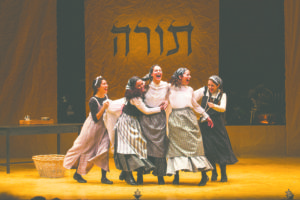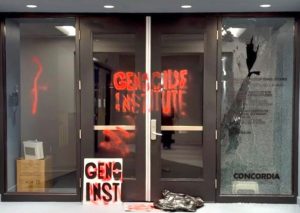Tim Morris is a balding, smoky-eyed, 58-year-old Irishman who’s worn a kilt instead of pants every day for the last 12 years. One would not expect him to speak fluent Yiddish. And yet, his love of the language traces back to his childhood years in Toronto, growing up during the 1960s and ’70s with Jewish friends who showed him Yiddish schoolbooks and chatted giddily about their Yiddish classes.
“It all seemed like a fascinating and interesting language,” he recalls. “It seemed to be deeply rooted in Toronto’s history.”
But it would be decades later, after witnessing his son’s university graduation, that Morris decided to enrol at the University of Toronto’s medieval studies department, returning to academia for the first time since dropping out of college to work full time at age 17. Once he saw Yiddish as a course offering, he jumped at the chance to scratch his decades-old itch, earning scholarship awards for top marks in his Yiddish classes three years in a row. He now spends his free time translating old Yiddish texts and tutoring other students, while pursuing his PhD.
But isn’t his fondness of Yiddish a bit weird, given that he isn’t Jewish?
“I don’t feel I’m an intruder,” he says. “I like to think, and I’ve always felt, that the treasures of secular Yiddish culture – the works of Sholem Aleichem and Mendele Mocher Sforim and others – are part of an international, global human heritage.… It was a gift that Jewish people gave to the whole world.”
Despite what you may think, Morris is actually a good representation of the future of Yiddish: secular, urban, global, bookish, hipster. This is not the Yiddish of payot and textbooks, but of podcasts and online journals; a little less klezmer, a little more pop culture.
Morris is one of an estimated 600,000 fluent Yiddish speakers worldwide, according to a report from the department of Jewish studies at Rutgers University – a far cry from the 11 million who spoke it at the dawn of the Holocaust. In Canada alone, the number of people who say that Yiddish is their mother tongue dropped from nearly 150,000 in 1931, to a scant 13,555 in 2016, according to census data. This is in part because Israel adopted Hebrew as its national language, and partly because diaspora Jews assimilated in the West. Mostly, the older generation has simply died off.
The language’s geographic centres have since shifted from eastern Europe to North America, clustering around major Jewish urban areas such as Toronto, Montreal and New York. And therein lies the secret: a seeming result of that westward trend has been the language’s artistic renaissance, dovetailing with the Internet revolution and millennials’ sweeping fascination with any aesthetic deemed offbeat and vintage.
This summer has seen an explosion of Yiddish culture bursting into the mainstream. The New Yorker recently published a deep dive into Yiddish Glory: The Lost Songs of World War II, a collection of once-lost Yiddish songs written during the Holocaust, which were found and revived by Yiddish professor and CJN columnist Anna Shternshis. On Aug. 28, a live performance of those songs will open Toronto’s Ashkenaz Festival, one of the world’s predominant showcases of Yiddish and klezmer music.

In New York, the National Yiddish Theatre Folksbeiene extended its popular Yiddish adaptation of Fiddler on the Roof until October. “For those who grew up around Yiddish, its use here will likely strike a deep emotional chord,” wrote Jesse Green in a review of the play in the New York Times. “For me, it’s not just the fusillade of familiar words and phrases: meshugge, geklempt, zay gezunt. It is the sound of my own grandparents and all they lost in leaving their Anatevkes.”
In Canada, Montreal’s Yiddish arts scene, which includes the Dora Wasserman Yiddish Theatre (one of the few functioning Yiddish theatres still in existence), is the birthplace of Yidlife Crisis, a Yiddish web series about two kvetching friends. The series grew popular enough that the creators were able to nab cameos from Jewish stars like Howie Mandel and Mayim Bialik, paving the way for a third season that started filming earlier this month.
“We were trying to imagine what conversational Yiddish would be like today – for secular Jews – if it had not been wiped out by the Holocaust,” co-creator Eli Batalion told The CJN in 2014, when the series premiered.
That casual vibe is what makes Yidlife Crisis unique in the Yiddish art world: while the klezmer and theatre scenes are quietly growing, one still doesn’t hear too many people speaking Yiddish conversationally, other than in some Hasidic communities.
READ: SHTERNSHIS: YIDDISH CULTURE IS BOOMING
“Yiddish will continue to flourish under the Hasidim. Yiddish as a language of writers will not, because the Hasidim don’t read those works,” said Joseph Berger, author of The Pious Ones: The World of Hasidim and Their Battles with America, in an interview with The Atlantic.
“They use Yiddish as their lingua franca and to discuss the Torah. They don’t read secular works.”
Berger’s statement may be wrong, however, in its assumption that the future of Yiddish is contingent on the future of ultra-Orthodox Jews. In fact, this newfound Yiddish renaissance is often tailored to mainstream audiences and left-leaning artists who are currently carving out their own community.
“There’s a very keen sense that Yiddish is a friendly space for the arts,” says Miriam Udel, who teaches the language at Emory University and the Yiddish Book Center in Amherst, Mass. Her classroom at the Yiddish Book Center comprises artists, architects and playwrights who are drawn to the language’s progressive past and want to marry that with their own Jewish identities.
“Most of the voices that created what became canonical Yiddish culture had some kind of progressive political engagement,” she says.
Sandy Fox is continuing that tradition. She started studying Yiddish in 2013, around the same time she became more engaged in Middle Eastern politics and began questioning her Zionist upbringing. “I realized the language would give me access to this whole world I felt was hidden from me,” she says.
By the time she had a better grasp of the language, in 2016, she was able to launch a Yiddish-language feminist podcast called Vaybertaytsh. “For the language to grow and live,” she says, “it needs to be used to talk about all sorts of things. It can’t always be self-referential.”
Many young, urban Jews are following a similar pattern. Rachel Epstein, the executive director of the Winchevsky Centre, a secular Jewish organization in Toronto with roots in the Yiddish labour movement of the early 20th century, recalls an intergenerational event that her group recently held, in which young Jewish activists sat down to chat with older ones, like platonic social justice speed dating.
“Many of those older people’s histories are rooted in Yiddishkeit,” Epstein says. “I think that was fascinating for young people – they want that history. There’s a lot of fear of it dying.” Members have since asked her to bring Yiddish courses back to the Winchevsky Centre, and she’s hoping that anyone interested in learning or contributing will get in touch with her.
Kathy Friedman sees that same cultural curiosity in even younger Jews. She’s the director of Jewish studies at Bialik Hebrew Day School in Toronto, which is one of the only Hebrew schools in North America to offer Yiddish classes. (It’s mandatory from grades 3 to 8.)
“We saw it as a source for creating both the memories and the narrative of who we are as a Jewish people,” Friedman says. “The children perceive and feel that Yiddish is something that’s a piece of them.”
This coming year, she’s spearheading a major overhaul of Bialik’s curriculum, particularly its Yiddish classes. “We’ve moved away from just conjugation,” Friedman explains. They are instead focusing on integrating the language more naturally into arts and culture, emphasizing modern Yiddish poetry, music and theatre.
“Education is taking a big shift,” she says. “We’re thinking differently, children are thinking differently.”
Part of that shift, she says, is driven by technology. Online Yiddish learning tools like YiddishPop, a branch of the BrainPop educational site, have made studying and absorbing the language far easier for children.
Adult learners have unprecedented digital resources, too: the Yiddish Book Center offers more than 11,000 Yiddish titles and 100 audiobooks as part of its online library, which includes rare texts that have been scanned and uploaded for posterity. In a further nod to modern language learning, several staffers are currently creating a Yiddish course on Duolingo, the world’s most popular language-immersion app, which boasts 200-million users.
“The world of Yiddish is just like anything else: it’s adapted,” says Rokhl Kafrissen, a journalist and Yiddishist in New York. “Technology can make anything possible and easier, but humans still have to decide to invest their time and resources into actually doing these things.”
According to Kafrissen, the Yiddish scene in 2018 is “a different world” from when she first picked up her College Yiddish textbook at Brandeis University in 1994, thanks to Skype classes and social media. She points to In geveb, a sleek, online-only journal of Yiddish studies with editors and board members contributing from around the world, as an example of something that was “unimaginable” 20 years ago.
Because of all this reinvigoration, Kafrissen stands among those Yiddishists who roll their eyes at the ongoing talk of a “Yiddish revival.” For her, there’s so much Yiddish activity that we can’t reasonably call this a revival anymore – this is the adolescence of a new Yiddish culture.
“When does a revival become something else? After 25 years? 35?” Kafrissen wrote in Forward in 2010. “How many centres, institutes and festivals does it take to transform a revival into something permanent? When will we finally start using the word ‘continuity’ to describe the now decades-long ferment of Yiddish culture?”
Prof. Shternshis agrees. “Yiddish is turning away from a language of the past,” she says. The new Yiddish is contemporary and diverse, something she sees reflected in her classroom, when she looks out at her Asian, German and Irish students, like Tim Morris.
“It’s becoming this global demographic of learning Yiddish,” she says. “Yiddish has got this new blood in it.”
Author

Michael is currently the director of The CJN's podcast network, which has accumulated more than 2 million downloads since its launch in May 2021. Since joining The CJN in 2018 as an editor, he has reported on Canadian Jewish art, pop culture, international travel and national politics. He lives in Niagara Falls, Ont., where he sits on the board of the Niagara Falls Public Library.
View all posts







